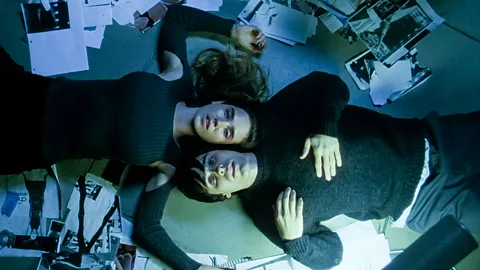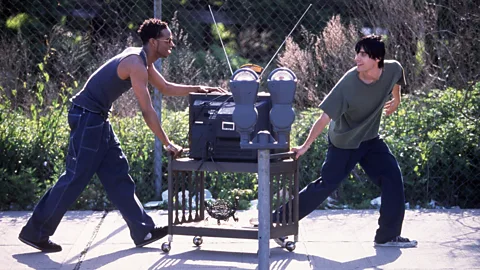'Slumming in a vision of hell': Why Requiem for a Dream is still so divisive, 25 years after its release
 Alamy
AlamyDarren Aronofsky's radical drug-addiction drama was highly acclaimed and angrily slated when it came out in 2000. Today, this Hubert Selby Jr adaptation is no less contentious.
When Requiem for a Dream debuted 25 years ago in May 2000, it drew both rave reviews and a firestorm of controversy. The midnight screening at the Cannes Film Festival culminated in a rapturous standing ovation from the auditorium's 3,000 spectators. When the lights came up on author Hubert Selby Jr – who had written the 1978 novel on which the film was based – tears were streaming down his face. Critical iration followed, with the Guardian's Peter Bradshaw rhapsodising that director Darren Aronofsky had reached the legendary heights of Orson Welles in "energy, consistency, and utter mastery of technique".
The reception played out very differently, however, at the Toronto Film Festival, where some audience vomited in disgust. Saddled with a restrictive NC-17 rating, the film went on to gross a lean $7.5m (£5.5m) on a $4.5m (£3.3m) budget, and was lambasted by some detractors for, as Jay Carr put it in the Boston Globe, "slumming in a vision of hell hatched from bourgeois comfort".
What divided critical reaction was how Requiem for a Dream depicted drug addicts – which is to say, in up-close, harrowing detail. The film follows a widow, Sara Goldfarb (Ellen Burstyn), as she becomes hooked on diet pills in an effort to become a contestant on a television game show. Meanwhile, her son Harry (Jared Leto) and his best friend Tyrone (Marlon Wayans) hatch a scheme to get rich selling heroin. When things go south, they pressure Harry's girlfriend Marion (Jennifer Connelly) to trade sex for drugs. The plot swirls like a whirlpool that draws them toward their gruesome fates: torturous treatments of electroconvulsive shock therapy, amputation of a gangrenous arm, conscription into a prison work gang overseen by a racist guard, and exploitation in humiliating sex work.
The film-makers set out to deliver a sensory bombardment that would mimic the experience of addiction. But they ended up doing much more, touching off serious debates about the free will of the addict, the line between comionate observation and exploitative voyeurism, and the toxic siren call of the American Dream itself. Twenty-five years later, these debates are still smouldering.
The idea for the film came when producer Eric Watson noticed a copy of Selby's novel sitting on Aronofsky's bookshelf in 1998. "Darren told me he'd had to stop reading halfway through – it was just too dark and unrelenting – and that intrigued me," Watson tells the BBC. "I asked him if I could borrow it for something to read on a ski trip with my parents. It completely ruined my holiday. I told Darren when I got back, 'This is the one – we've got to make this movie'. So we optioned the novel for a thousand bucks, and rather than wait for Selby to find the screenplay that was lost in his attic, Darren wrote one himself."
 Alamy
AlamyAronofsky and Watson sent the script to all the major studios. The response? "Crickets," Watson recalls. "No one even bothered to call us back to turn it down." Undeterred, they secured half the funding they needed from Artisan Entertainment, and brought aboard an independent producer, Palmer West, to help gather the rest of a shoestring budget. The casting process proved challenging, too. "Tobey Maguire, Adrien Brody, Joaquin Phoenix, Giovanni Ribisi – they all explored the project or showed up to audition to be Harry, but turned down the part," Watson recalls. "It was just too much of a career risk."
Once Leto, Connelly, Wayans and Burstyn were cast, the actors strove for authenticity. Leto shed 25lb (11kg) and hung out with homeless heroin addicts in New York's East Village. Wayans roamed the freezing streets of Brooklyn's Brighton Beach shirtless in February. When shooting commenced, Burstyn simulated her character's unhealthy weight loss by donning a 40lb (18kg) fat suit for her initial scenes, then swapping it out for a 20lb (9kg) suit, and finally taking two weeks off and losing 10lb (4.5kg) on a strict cabbage soup diet.
Depicting drug addiction
Aronofsky, inspired by Spike Lee's tracking shots from Do the Right Thing, used SnorriCam shots – cameras rigged to the body of the actor – to convey a dissolving sense of external reality. To this he added split screens, accelerations and decelerations, fades to white, title cards, camera spirals, fish-eye lenses, extreme longshots, pixelations, and surrealist mises-en-scène – all tools for mimicking the sensory distortions induced by opioids. (Proof that these techniques had made an impression came a few years later when The Simpsons featured an unmistakable homage.)
But even as these visual effects won enthusiasm, the film's take on drug addiction stirred up controversy. Whereas Trainspotting (1996) had been pilloried for glorifying a cultural aesthetic of "heroin chic", Requiem for a Dream was seen as offering an unremittingly bleak portrait of substance use. The image of a "spiral" became the critics' standard metaphor to describe its implication that addicts, once hooked, are pulled almost inexorably toward horrific ends.
"How it depicts the trajectory of heroin addiction is remarkably accurate, I'm sad to say," says David J Nutt, a professor of neuropsychopharmacology at Imperial College London. "Most start using out of desperation or hopelessness, but a good number, like Harry and Tyrone, see the drug trade as an entrepreneurial venture, as a way to make a quick buck and then get on with their lives. But it seldom ends well."
Meanwhile, Prof Nutt sees Sara Goldfarb as being emblematic of a whole generation of housewives in the 1950s and 1960s who "were casually prescribed amphetamines without appropriate supervision from doctors". As for Marion's fate, he says that today "pimps continue to control and abuse women by exploiting their addictions".
But the core of what the film gets right, adds Prof Nutt, is that it dramatises addiction as a chemical disorder in the brain that induces compulsive behaviour. "You don't resort to reusing extremely painful injection sites unless you're in the grip of irresistible urges," he says.
More like this:
• How Easy Rider revolutionised Hollywood
Not all addiction experts agree. Gene Heyman, a senior lecturer in the department of Psychology and Neuroscience at Boston College, tells the BBC that Requiem for a Dream irably depicts the euphoria of initiation into drugs followed by worsening bouts of painful withdrawal. But that's where its accuracy ends.
"This movie tells a familiar story: once an addict, always an addict, and it's necessarily a downward trajectory from which no one recovers," Heyman says. "And that's just plain false. All the epidemiological data show that by the age of 30, the majority of heavy drug s mature out of use – they stop using and don't begin again – and they do it without treatment or professional intervention. And that's just the data, not my opinion. It's there for everybody to see."
The American Dream
For his part, Watson has grown exasperated with fielding questions about the accuracy of addiction in Requiem for a Dream. "Hubert Selby was very active in AA and NA [Alcoholics Anonymous and Narcotics Anonymous], but our film was never meant to double as a documentary or a road-to-recovery pamphlet," he says. "No, it's not realistic. It's surreal. Chill out."
Selby himself was always adamant that he saw drug addiction as just one manifestation of the seductive power of the American Dream – and what he saw as its toxic effects. Ahead of the film's release, he wrote a new foreword to his novel, which said: "Obviously, I believe that to pursue the American Dream is not only futile but self-destructive because ultimately it destroys everything and everyone involved with it."
Many critics have come to see Requiem for a Dream as being in the same vein as The Great Gatsby (1925) and Revolutionary Road (1961), works that expose the dark underbelly of the American mythos. With its junk television and junk food, the film is grounded in a specifically American milieu of addictions, says Kevin Hagopian, a Media studies professor at Penn State University.
 Alamy
Alamy"The studio game show that entrances Sara is all about manufacturing an anxious, jacked-up, bogus joy," he says. "Here you have an insane grasping after unrealistic panaceas, a shortcut to a quick fix so you never have to think about your purpose in life. Here, the American Dream isn't the thing that needs pursued – it's the ultimate villain. And that critique is so devastating to the myths that prop us up that it's no wonder a lot of people can't stomach it."
Danny Leigh, now a film critic at the Financial Times, lavished praise on Requiem for a Dream in Sight and Sound magazine when it was first released. "I was swept up in what was undeniably a stylish piece of film-making, with its raw cinematic brio," Leigh tells the BBC. "Trainspotting had been a seismic cultural event, touching off a giddy Britpop moment, and I saw Requiem as a powerful corrective, an almost parodic cautionary tale that stripped away the aura of cool and hit like a sledgehammer."
In the intervening years, however, Leigh has developed misgivings about Aronofsky's body of work. "I've come to feel there's a strain of prurience to his film-making, as though he's prying into emotionally desperate situations and bringing an unsavoury condescension, even voyeurism, to tragic circumstances." Leigh says this impulse reached its most grotesque extremity in Aronofsky's The Whale (2022), in which a reclusive and morbidly obese English professor, played by Brendan Fraser, eats his way to death.
Hagopian, by contrast, feels that Aronofsky has shown a genuine curiosity to understand people shunted to the margins of society. "Many experimental films create what I'd call nightmares of psychic distance," he says. "Think of David Lynch's Blue Velvet (1986), or Michael Haneke's The Piano Teacher (2001), or Lynn Ramsay's We Need to Talk about Kevin (2011) – in all these, we never learn what the characters are really thinking or feeling." Requiem for a Dream, he says, takes the opposite approach by achieving what he calls a "nightmare of psychic intimacy".
"We're just forced so damn close to the characters that at some point their pain and trauma seem to leach into our own consciousness. It can feel claustrophobic, even invasive. But to me, that's the bravest sort of film-making, and it explains why this work of art, whether you ire or loathe it, is permanently seared into people's psyches."
Requiem for a Dream is available to watch on Peacock, Prime Video and Apple TV+ in the US and Sky Store, Prime Video and Apple TV+ in the UK
--
